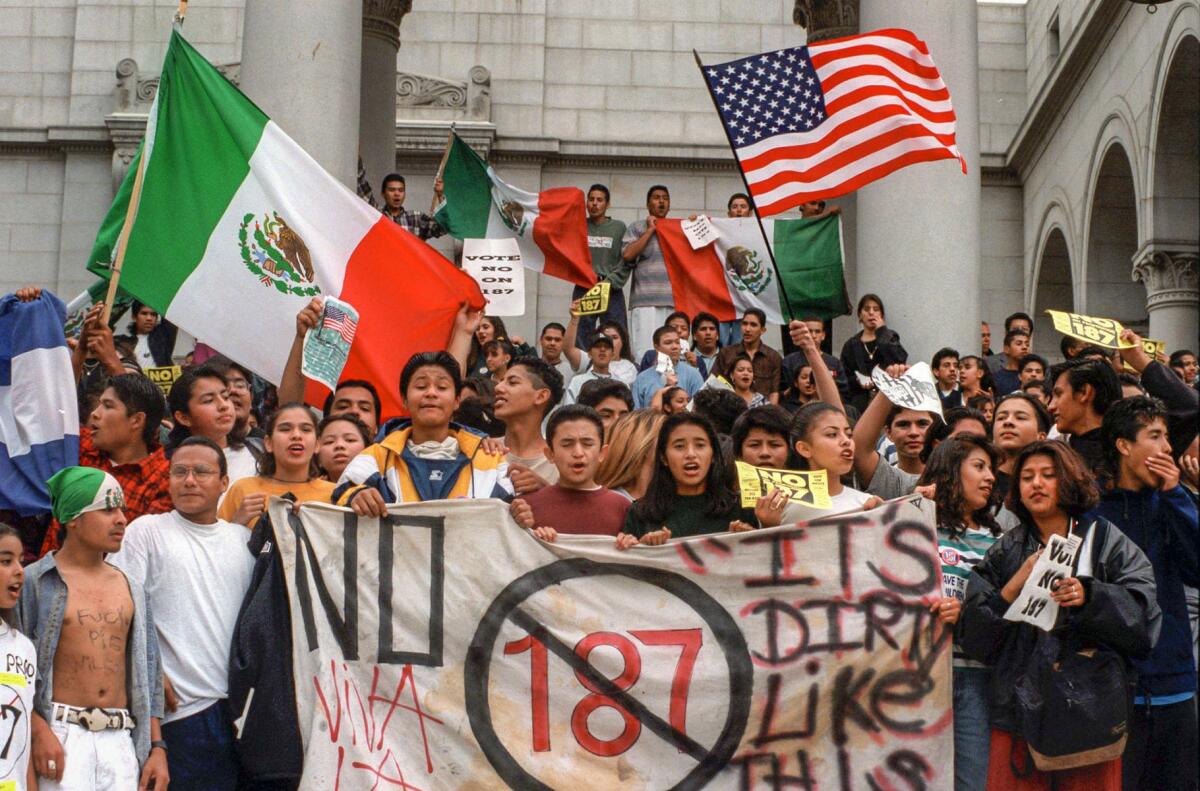California’s changing demographics will further doom Republicans

- Share via
SACRAMENTO — Democrats dominate politics in California and Republicans are doomed for one simple, overriding reason: shifting demographics.
In short, the GOP’s core constituency is white people and they’re a declining slice of the California population pie. Conversely, Democrat-backing Latinos and Asian Americans have been expanding their slices.
That pattern is projected to continue, although at a slower pace. So the raw numbers won’t be getting any better for the already weakened California GOP.
“Republicans are heading into a demographic cul-de-sac,” says longtime Democratic strategist Bob Shrum, director of the Jesse M. Unruh Institute of Politics at USC.
“This is not just in California, but nationally. It’s happening here first. But it’ll tend to happen around the country.”
Republican guru Mike Murphy, who has worked on six presidential campaigns and managed several gubernatorial races — including former Gov. Arnold Schwarzenegger’s in 2003 — says “the Republican Party does great with white voters, particularly older white voters. But they’re shrinking as part of the electorate.”
“California is the future. It tends to be more non-Caucasian than most states. But we’re heading into that for the rest of the nation. And how are Republicans doing in California? They’ve got to figure out how to compete here or it’s the ice age.”
Demographics are an eye-glazer, but California’s historic shift has been a political game-changer. The state has turned from battleground purple to one-sided deep blue in 25 years.
It’s not solely — arguably not even mostly — because of the 1994 Republican-backed anti-illegal immigration initiative, Proposition 187. That measure usually gets the credit or blame, depending on one’s politics.
The initiative would have denied most public services, including schooling, to people living here illegally. Voters approved it in a landslide. But federal judges tossed it out.
No question, the harsh campaign pitch for Proposition 187 angered and frightened millions of Latinos, turning them even more against the GOP. It also sparked a new generation of Latino state political leaders.
This is Murphy’s analogy: “Pretend you’re buying a car. You go to a Republican dealership and the salesman’s first line is, ‘I want to throw your parents and grandparents in jail. Now let me tell you about the new Chevys.’ And the dealership wonders why it isn’t selling any cars.”
Today, six of eight statewide elected officials are people of color — three are Latino, two are Asian American and one is African American. All eight are Democrats. Republicans haven’t elected a statewide official since 2006. Democrats hold supermajorities in both legislative bodies and own California’s U.S. House delegation 46 to 7.
But all this probably would have happened even if Proposition 187 had never existed. The divisive initiative just made the transition to total power easier for Democrats.
The GOP demise was inevitable given its increasingly hard-line conservatism as pragmatic moderates left the party. The shrinking GOP was on opposite sides of Democrats and independents on many issues: gun control, abortion, environmental protection, taxes and spending, immigration and a border wall — not to mention their opinions of the immigrant-bashing polarizer in chief, President Trump.
In 1990, Republicans made up 39% of California’s registered voters. Today they’re down to 23.6%. That’s third place behind independents, who since 1990 have soared from 9% to 26.7% Democrats have dropped slightly, from nearly 50% to 44%.
It’s all in the numbers.
In 1990, 57% of California’s population was white. Latinos constituted about 26%, with Asians at 9% and African Americans at 7%. In 2020, the population is estimated to be 39.4% Latino, 38.2% white, 13% Asian and 5.7% black, according to the state Finance Department’s Demographic Research Unit. Projecting to 2040, the population pie is expected to be about 42% Latino, 35.6% white, 12.5% Asian and 5.9% black.
In Los Angeles County, a little over 26% of the population is white and that number is projected to dip to 24% by 2040. Latinos now are at nearly 50% and will rise to almost 53% in 2040.
The reason all this matters politically is that voters of color are snubbing the Republican Party and they’re increasing in numbers.
The majority of Latino likely voters, 58%, are registered as Democrats, according to the nonpartisan Public Policy Institute of California. An additional 23% are independents. Only 15% are Republicans.
Among Asian likely voters, 43% are Democrats and 36% are independents. Republicans claim just 18%.
A solid 72% of black voters are Democrats.
White voters? They’re mixed, as they’ve always been: 40% Democrat, 35% Republican and 20% independent.
The caveat for Latinos is that they’ve never exerted their full strength on election day. Their turnouts have been subpar.
But last November — probably because Trump was their lightning rod — they showed up in better numbers. They cast 21% of the total votes, according to Paul Mitchell, who runs a political data firm. Still, that’s underperforming. They were 26% of registered voters.
I called the California Republican Party’s new chairwoman, Jessica Patterson, the first woman and Latina to hold that post.
What can she do to revive the party? “It’s an incredible challenge,” she acknowledged.
“I’m focusing on the future, including engaging communities that haven’t always heard from Republicans — focusing on key issues facing California like homelessness and the skyrocketing cost of living … education, public safety….
“We need to talk about the Democrats’ failures, but also what we would do instead. We have to be more than a party of ‘no.’”
Don’t talk about the wall, however, unless you’re ready to say “no.” Trump’s wall is merely another barrier between Latinos and Republicans.
More to Read
Sign up for Essential California
The most important California stories and recommendations in your inbox every morning.
You may occasionally receive promotional content from the Los Angeles Times.











